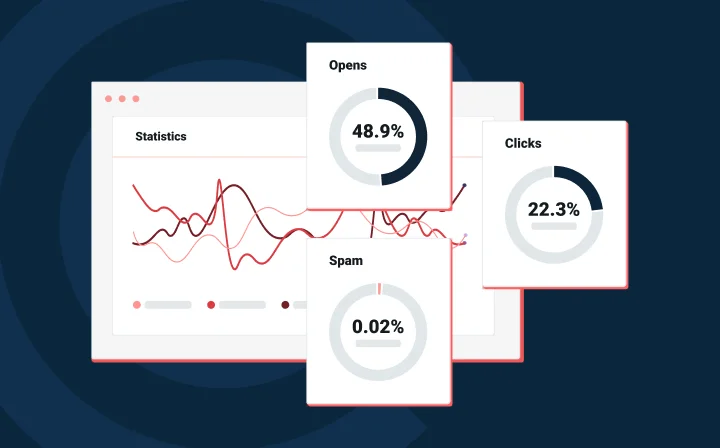Deliverability
How to avoid landing in an email blocklist: Best practices

Deliverability

We can’t think of many things more immediately impactful to your deliverability than landing on a blocklist. Once you’ve been flagged, ISPs won’t let you through the gate into the inbox, and that hurts everything from your engagement to your bottom line.
Let’s jump right into it.
A blocklist is a list of IP addresses or domain names that get flagged as sources of suspicious behavior, malicious content, or spam messages. There are many lists, but some pack more of a punch in terms of affecting your deliverability and sender reputation. Some popular blocklists include:
Email clients and email service providers (ESPs) may work to prevent emails from blocklisted domains from reaching their email servers. If your domain becomes blocklisted, your emails probably won’t reach your subscribers. In a nutshell, landing on a blocklist impacts your email deliverability and your sender reputation. If your messages do get through, they’ll most likely end up in the spam folder, not the inbox. In addition, some internet service providers (ISPs) restrict access to blocklisted IPs and domains.
So you’ve been blocklisted. Don’t worry – this isn’t the end of the world. We’ll go over how you can avoid getting blocklisted in the first place or how you can get delisted later on. But first, here are four common reasons you might been blocklisted:
Let’s take a closer look at each of these below.
Spammers often suddenly ramp up in volume. Blocklist vendors might see a sudden increase in your email volume as a red flag indicating that you’re sending out spam instead of legitimate emails. Avoid this by batching your emails or using email list segmentation to break up large mailing lists.
Your content might not be spam, but it’ll get flagged by blocklists if it looks like spam. While there are no set rules for exactly what spammy content looks like, here are some things to tips to avoid looking spammy:
If you’ve been exposed to a cybersecurity threat, the hacker might commandeer your account to send out spam. Not only does this ruin your sender reputation, but it might also land you on a blocklist. Implement good cybersecurity practices and use two-factor authentication (2FA) to guard against these threats.
Yes. This is bad. Very bad. If your subscribers can’t see a clear way to unsubscribe, they might mark your emails as spam. Too many spam complaints will land you on the blocklist.
Not sure if you’ve actually been blocklisted? Your ISP should signal whether any of your IP addresses or domain names are on an email blocklist, but sometimes things slip through the cracks. In this case, you can run a domain blocklist check on your email to see if your domain is on a blocklist.
To do this, run your domains manually through individual blocklists. Alternatively, you can save time by using a tool that runs your email against major blocklists. Check out Mailgun’s Blocklist Check Tool to see if your domains are on any blocklists. With this information, you can go back to the individual blocklists to see why your emails are getting flagged.
The good news about blocklists is that there are a few major ones that are impactful, like Spamhaus or Barracuda, and others that can be publicly referenced. The downside is that these lists will never seek out a domain to alert them of a blocked status.
This is where blocklist monitoring comes in, and why it’s important to use tools that have curated an extensive library of blocklists to validate your domain against.
The best course of action is preventative action. After all, blocklists just spell disaster for email open rates, conversions, and ROI. Keep your marketers happy by minimizing deliverability problems!
Take a look at our list of best practices so you can avoid landing on an email blocklist:
Let’s dive into each of these in more detail below.
Keep a healthy subscriber list by staying up-to-date with your mailing list. Remove unengaged users or email addresses that have bounced more than two times in a given time frame. Most importantly, before sending, be sure to verify your email addresses. Stop the problem before it happens!
Keep a healthy subscriber list by staying up-to-date with your mailing list. Remove unengaged users or email addresses that have bounced more than two times in a given time frame. Most importantly, before sending, be sure to verify your email addresses. Stop the problem before it happens!
Clear opt-in and opt-out options will save you a lot of headaches when it comes to invalid email addresses or spambots. For instance, double opt-in requires users to submit their email addresses in a web form and then open an email to confirm their email address and interest in your mailing list. Double opt-ins check whether or not a subscriber intended to sign up for a mailing list and whether they’ve input their emails correctly.
Having a clear opt-out or unsubscribe option is just as important as having a clear opt-in option. If your subscribers can’t find a clear opt-out button, they might just mark your emails as spam and call it a day. They might not think anything more of it, but enough of these spam complaints could land your domain on a blocklist.
We go into email authentication protocols in detail elsewhere, but let’s go over the basics again. You’ll need to set up the following protocols:
Use tools like our Email Automation API to send personalized, timely messages. Don’t use bulk emails, since most subscribers won’t engage with these impersonal messages. Remember, subscriber engagement affects whether or not your email ends up on the blocklist.
On a related note, you can also take advantage of our Send Time Optimization tool to contact your subscribers at the best time possible. This way, they’ll be more receptive to (and engage more with) your message when it lands in their inbox.
In today’s digital landscape, where email deliverability is more and more important, landing on a blocklist can be detrimental to your ability to get messages in front of your subscribers. This impacts your bottom line, as well as your future sending. By proactively monitoring and addressing blocklist issues as they arise, you can safeguard your reputation, maintain customer trust, and ensure your messages aren’t automatically flagged as spam by ISPs.

If you find yourself on a blocklist, you can request to have your blocked IPs delisted:
Not sure where to start? As a benefit of our Managed Service, we’ve automated monitoring of all major blocklists to check them in real-time. This means our team of experts will step in to deal with the blocklist providers on your behalf.
Blocklists do serve a purpose. Without them, we’d have much more spam in our inboxes. And that, in our opinion, is way worse than a temporary listing.
There are many layers to email, and the reputation layer is important. Did you find these tips for avoiding the blocklist and some tricks for getting delisted helpful? Well, we’ve got lots more where that came from, but we practice what we preach so you have to opt-in to our newsletter to stay in the loop.